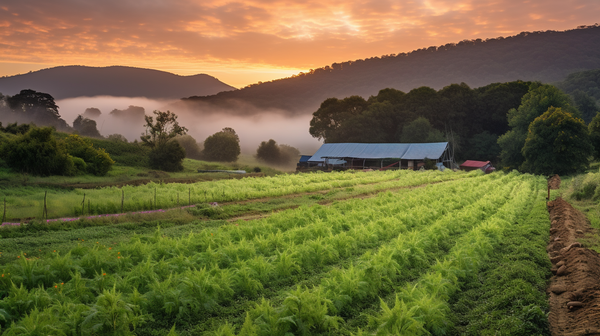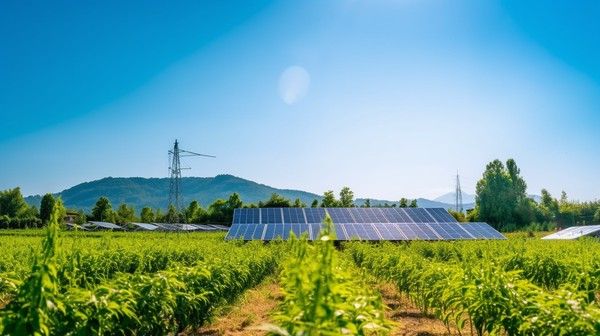"ECO-FRIENDLY CANNABIS GROWING: PAVING THE WAY FOR A SUSTAINABLE FUTURE"
As the cannabis industry continues to burgeon, it carries with it an increased responsibility towards sustainable cultivation practices. The imperative for a greener future in cannabis cultivation is not just an environmental necessity but also a business imperative, as consumers become more eco-conscious.
This comprehensive exploration delves into the various sustainable cultivation practices that are not only shaping the future of the cannabis industry but also ensuring its viability and harmony with the environment.

Introduction
The journey of cannabis from a stigmatized substance to a recognized medicinal and recreational product has been remarkable. However, this journey brings with it an environmental footprint that cannot be ignored.
Traditional cultivation methods, while effective, often result in significant water usage, energy consumption, and chemical runoff, posing threats to ecosystems and contributing to carbon emissions. In response, the industry is pivoting towards more sustainable practices, aiming to mitigate its environmental impact while meeting growing demand.
Eco-Friendly Cultivation Techniques
Transitioning to eco-friendly cultivation techniques is pivotal for the sustainable growth of the cannabis industry. These methods not only reduce the ecological footprint but also often result in a superior product, thereby enhancing market competitiveness.
- Organic Cultivation: Emphasizing the use of natural fertilizers and pest management techniques, organic cultivation eschews synthetic chemicals, promoting healthier soil and ecosystems.
- Water Conservation: Innovative irrigation systems such as drip irrigation and the collection of rainwater significantly reduce water usage, a critical factor in drought-prone regions.
- Renewable Energy Sources: Utilizing solar, wind, or geothermal energy to power cultivation facilities decreases reliance on fossil fuels, aligning operations with broader climate goals.(3 unusual ways renewable energy is giving farming a boost)
- Integrated Pest Management (IPM): IPM strategies use biological control agents and environmentally sensitive chemicals, minimizing harm to non-target species and the environment.
Innovative Technologies in Sustainable Cannabis Cultivation
The integration of technology in cannabis cultivation is leading to leaps in sustainability, with advancements in lighting, climate control, and automation playing pivotal roles.
- LED Lighting: Compared to traditional HID lamps, LED lighting offers substantial energy savings and reduced heat output, allowing for closer placement to plants and less energy use for cooling.
- Automated Systems: Automation in climate control and irrigation ensures optimal resource use, reducing waste and enhancing efficiency.
- Data Analytics: Leveraging big data and AI for predictive analytics can optimize growing conditions, further reducing resource consumption and improving yields.
Regenerative Agriculture Practices
Regenerative agriculture goes beyond sustainability, aiming to improve and rejuvenate the soil. Practices such as crop rotation, cover cropping, and reduced tillage not only enhance soil health but also sequester carbon, contributing to climate change mitigation. (WHY REGENERATIVE AGRICULTURE?)
The Role of Policy and Certification
Policy frameworks and certification programs play a crucial role in promoting sustainable practices within the cannabis industry. Regulations that incentivize green practices and certifications like organic or sustainably grown labels help guide consumer choices and industry standards.
Enhancing Water Efficiency in Cannabis Farms
Optimizing water use in cannabis cultivation is vital for sustainability, especially in drought-prone areas. Technologies like drip irrigation and soil moisture sensors can dramatically cut water waste, ensuring plants receive precise hydration.
These methods are not only eco-friendly but also cost-effective, proving that responsible water management is feasible and beneficial for cannabis growers.
Powering Cultivation with Renewable Resources
Switching to renewable energy is a transformative step for the cannabis sector. Utilizing solar, wind, and biomass for energy needs can substantially reduce the carbon footprint of cultivation activities.
This approach supports environmental goals and can lead to significant savings, making it an attractive option for forward-thinking cannabis businesses.
Leveraging Genetic Advances for Eco-Friendly Cultivation
Cannabis genetics research is unlocking strains that are pest-resistant, disease-tolerant, and require fewer resources.(Hemp and Cannabis Crop Diseases) These developments reduce the reliance on harmful chemicals and adapt cultivation to diverse environments, enhancing the sustainability of the industry.
By investing in genetic innovation, cultivators can contribute to a more sustainable and resilient cannabis future.
Promoting a Circular Economy Within the Cannabis Sector
The cannabis industry can greatly benefit from adopting circular economy principles, where waste is minimized and resources are reused.
Techniques such as composting plant waste(Composting At Home) and creating biodegradable packaging from excess material can significantly lower environmental impacts, showcasing the potential of waste as a valuable resource.
Encouraging Sustainable Practices Through Policy and Consumer Action
The path to sustainable cannabis cultivation requires effort from both the industry and its consumers. Regulatory incentives for eco-friendly practices and consumer support for sustainable brands can drive significant change.(The Elusive Green Consumer)
By advocating for and choosing sustainability, we can collectively foster a more responsible and environmentally conscious cannabis industry.

Integrating Pest Management with Ecosystem Health
Sustainable pest management strategies, such as integrated pest management (IPM), offer a balanced approach to protecting cannabis crops while preserving biodiversity.
By employing biological control agents, beneficial insects, and natural repellents, cultivators can reduce their reliance on chemical pesticides, fostering a healthier ecosystem around their cultivation sites.
This method not only safeguards the crop but also supports surrounding wildlife, promoting a harmonious coexistence with nature.
Advancing Soil Health through Organic Practices
The health of the soil is foundational to sustainable cannabis cultivation. Adopting organic farming practices, such as cover cropping, crop rotation, and the use of organic fertilizers, can enhance soil fertility and structure.
These practices not only improve the quality and yield of the cannabis but also reduce soil erosion and degradation, ensuring that the land remains productive and healthy for future generations.
Leveraging Technology for Sustainable Growth
Emerging technologies, such as artificial intelligence (AI) and blockchain, are set to revolutionize sustainable cannabis cultivation. (AI in Agriculture — The Future of Farming)
AI can optimize growing conditions, reducing resource waste, while blockchain can ensure transparency and traceability in the supply chain, from seed to sale. These technologies not only enhance efficiency and sustainability but also foster consumer trust in eco-friendly cannabis products.
Navigating the Challenges of Sustainable Cannabis Cultivation
Sustainable cannabis cultivation faces significant hurdles, from regulatory complexities to the high costs of green technologies.(Why is renewable energy so expensive?) Navigating the patchwork of state and federal regulations can be daunting for cultivators aiming to implement eco-friendly practices.
Additionally, the initial investment required for renewable energy systems, water-efficient irrigation, and organic certification can be prohibitive for smaller operations.
These challenges necessitate a collaborative approach, where industry, government, and financial institutions work together to create an enabling environment for sustainable cultivation.(The Power of Global Collaboration: A Sustainable Approach to Agriculture and Climate Change)
Crafting Solutions for a Greener Cannabis Industry
To overcome these obstacles, a multi-pronged strategy is essential. Financial incentives, such as grants, low-interest loans, and tax breaks, can lower the barrier to adopting sustainable technologies.
Furthermore, clear and supportive regulatory frameworks can encourage cultivators to transition to eco-friendly practices without fear of non-compliance. Education and training programs can equip growers with the knowledge and skills needed for sustainable cultivation, fostering a culture of environmental stewardship within the industry.

Envisioning the Future of Sustainable Cannabis Cultivation
The future of sustainable cannabis cultivation is bright, with innovations in technology and a growing consumer demand for eco-friendly products driving the industry forward. Advances in genetic research will likely produce more resilient and resource-efficient cannabis strains.(Genetic Research and Plant Breeding)
At the same time, the integration of AI and IoT devices(AI For IoT: Paving the Way to a Connected and Intelligent Future) could optimize resource use and reduce waste, setting new standards for sustainability in agriculture.
As the global community becomes increasingly aware of environmental issues, the demand for sustainably produced cannabis is expected to rise, further incentivizing the industry to adopt green practices.
This confluence of technology, consumer awareness, and regulatory support holds the promise of a cannabis industry that not only thrives economically but also contributes positively to the health of our planet.
Conclusion
FAQs
Q: What makes cannabis cultivation particularly challenging in terms of sustainability?
A: Cannabis cultivation poses unique sustainability challenges due to its historically indoor-centric growth model, which demands significant energy for lighting, climate control, and ventilation. Additionally, the need for water and the use of fertilizers and pesticides can lead to considerable environmental impacts if not managed responsibly.
Q: How do LED lights contribute to sustainable cannabis cultivation?
A: LED lights are pivotal in sustainable cannabis cultivation due to their energy efficiency, lower heat emission, and longer lifespan compared to traditional lighting systems. This not only reduces energy consumption but also minimizes the need for cooling systems, further conserving energy.
Q: Can sustainable practices impact the quality or yield of cannabis?
A: Yes, sustainable practices can positively impact the quality and yield of cannabis. Techniques such as organic cultivation and precision agriculture can enhance soil health and plant vitality, leading to higher quality yields. Moreover, sustainable practices often lead to more resilient plants and ecosystems.
Q: Are there any certifications for sustainable cannabis cultivation?
A: Yes, there are several certifications that cannabis cultivators can obtain to validate their sustainable practices. These include organic certifications, sustainability certifications, and certifications for water conservation and energy efficiency, among others. These certifications help consumers make informed choices and encourage industry-wide adoption of sustainable practices.
Q: How can consumers contribute to promoting sustainable cannabis cultivation?
A: Consumers can play a significant role by being informed and making conscious choices. Opting for products from brands that prioritize sustainability, seeking out certified products, and supporting policies that encourage green practices in the cannabis industry are effective ways consumers can contribute.
--
"Discover a world of discretion and elegance with our unique humidor stash boxes. Check out our website now to explore our exclusive collection!"
--
|
More Articles here |
| "ELEVATE YOUR CANNABIS EXPERIENCE: A COMPREHENSIVE SMOKING GUIDE" |
| "THE ESSENTIAL GUIDE TO THC: EVERYTHING YOU NEED TO KNOW ABOUT CONSUMPTION AND EFFECTS" |








